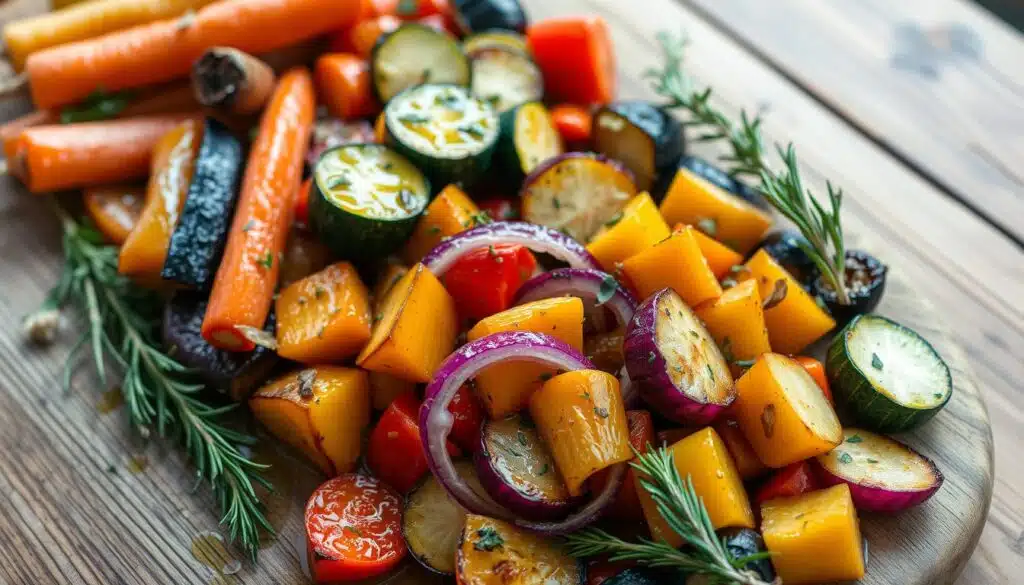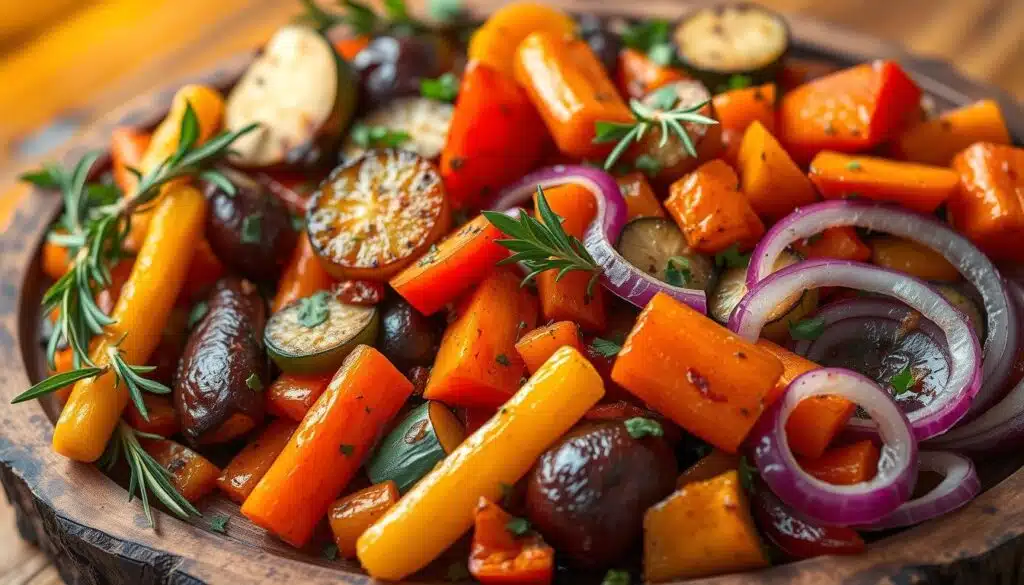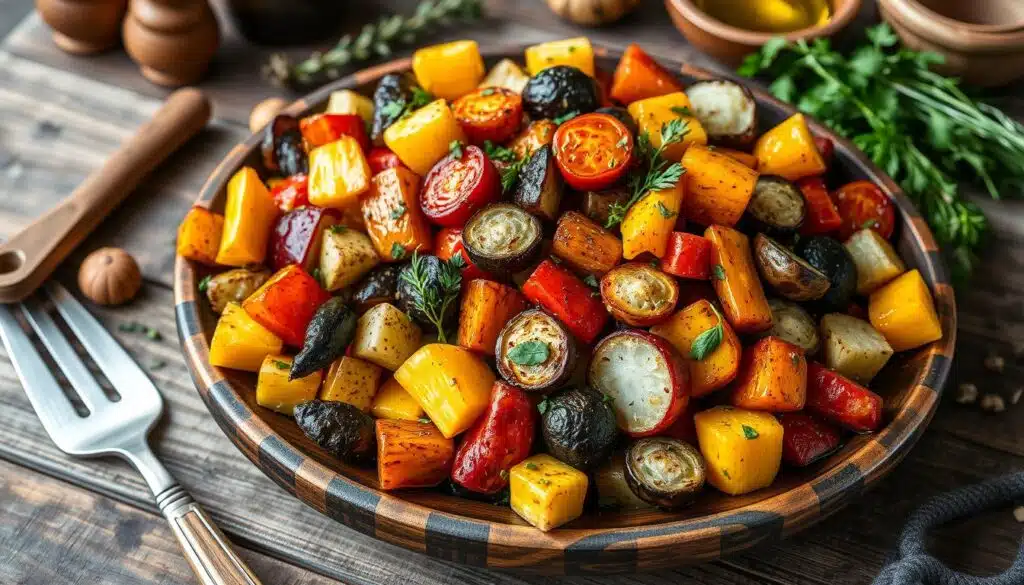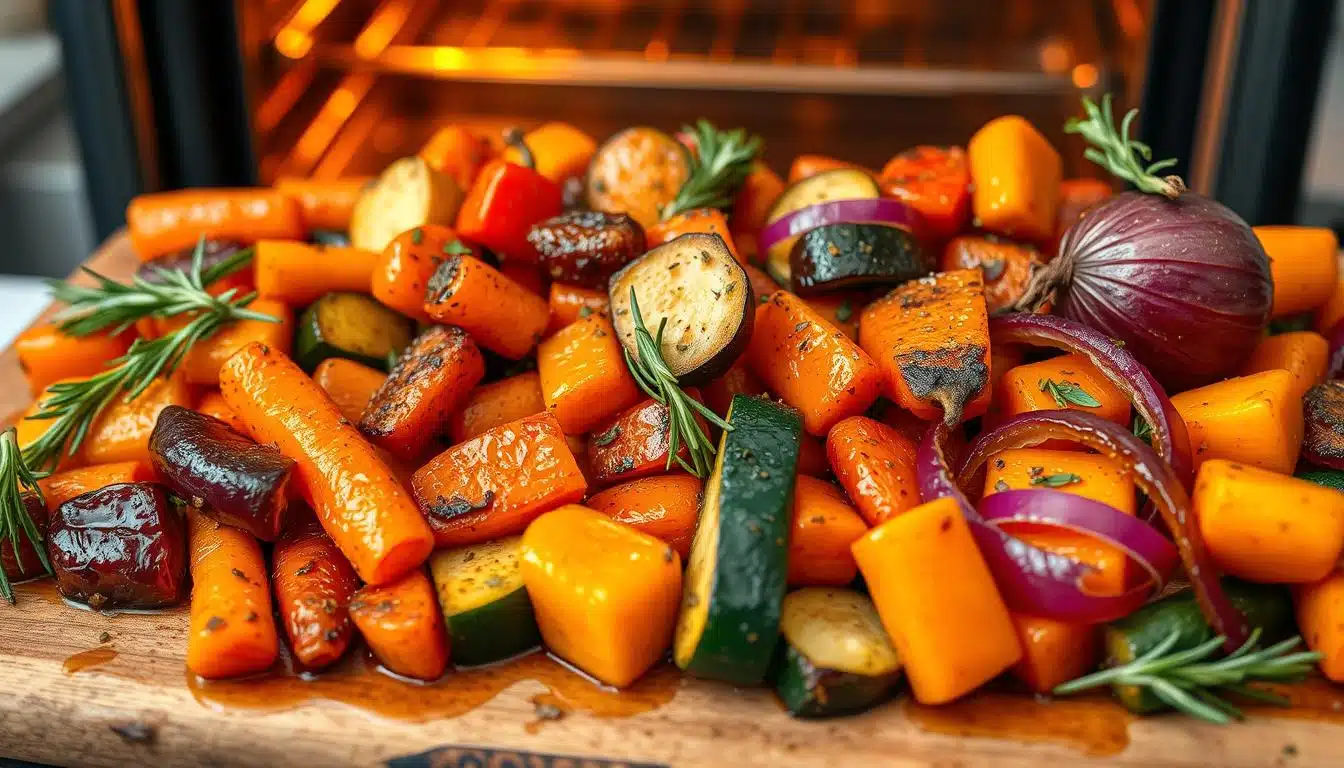I’m excited to share my favorite easy roasted vegetable recipe. It’s perfect for any meal! Roasted vegetables add flavor and nutrition to your diet. With the right herbs, you can make a delicious side dish that smells amazing.
Imagine having a tasty and healthy side dish ready in no time! That’s what roasted vegetables with herbs offer. This easy recipe makes a perfect side dish for any occasion.
Looking for a quick and healthy recipe? Roasted vegetables with herbs are the answer! They’re great for a busy lifestyle. With the right herbs, you can make a dish that’s both delicious and nutritious.
Key Takeaways
- Roasted vegetables are a great way to add flavor and nutrition to your diet
- Easy roasted vegetable recipe can be ready in no time
- Delicious vegetable side dish can be made with the right herbs
- Roasted vegetables with herbs are perfect for a busy lifestyle
- Healthy side dish can be made with a few simple ingredients
- Roasted vegetables are a great way to get your daily dose of nutrients
Introduction to Roasted Vegetables
I’m excited to share the benefits of roasted vegetables. This cooking method enhances the flavors and textures of your favorite veggies. By choosing the right veggies and herbs, you can make a dish that’s both tasty and nutritious. Roasted vegetables are a great way to add flavor to your meals and are perfect as a healthy side dish.
For cooking inspiration, I always recommend CookioCraft. Their website is full of amazing recipes and tips. Roasted vegetables are versatile – you can use any veggies you like and add your favorite herbs and spices for a unique flavor.
Some benefits of roasted vegetables include:
- Retaining their nutritional value
- Adding extra flavor to your meals
- Being a healthy and delicious side dish option
Cooking is all about experimenting and having fun. So, don’t be afraid to try new things and come up with your own recipes. Nutritious herb-roasted veggies are a great starting point. With practice and patience, you’ll soon be making delicious roasted vegetables like a pro!
So, why not try roasted vegetables? They’re easy to make, delicious, and full of nutrients. Remember, the key to great roasted vegetables is using high-quality ingredients and experimenting with different herbs and spices. Happy cooking!
Selecting the Right Vegetables
Choosing the right vegetables is key for quick and simple roasted dishes. I always pick seasonal vegetables for their freshness and flavor. This makes my roasted veggies not only tasty but also healthy. For easy dinner ideas, I look at what’s in season and plan my meals accordingly.
I start by visiting my local farmer’s market or grocery store. I search for vegetables that are bright in color and firm. My top picks include Brussels sprouts, carrots, and sweet potatoes. These veggies are not only delicious but also full of nutrients, making them perfect for any meal.
Seasonal Vegetables for Roasting
- Brussels sprouts: perfect for fall and winter meals
- Carrots: great for spring and summer roasting
- Sweet potatoes: delicious year-round
How to Choose Quality Produce
When picking vegetables, I look for a few important things. I check for any damage or bruising. I also make sure the vegetable is firm and has a vibrant color. Choosing quality produce ensures my roasted veggies are both delicious and healthy. With a bit of practice, you can pick the best veggies for your meals.

Preparing Vegetables for Roasting
Preparing vegetables for roasting is a key part of my quick dinner recipes. To get the best roast, start with the right prep. Cut your veggies into even sizes for even cooking.
For easy dinner ideas, cut them into bite-sized pieces or slices. This depends on the vegetable type.
Here are some tips for cutting and washing your vegetables:
- Cut vegetables into uniform sizes to ensure even cooking.
- Wash your vegetables thoroughly to remove any dirt or debris.
- Dry your vegetables with a clean towel or salad spinner to remove excess moisture.
By following these straightforward steps, you can effortlessly prepare a delicious and healthy easy roasted vegetable recipe. These flavorful vegetables are a perfect accompaniment to any quick dinner recipes or form the basis of simple and easy dinner ideas. For the most satisfying taste and optimal texture in your easy roasted vegetable recipe, always prioritize selecting fresh, seasonal vegetables.
With these tips, you’ll make mouth-watering roasted veggies. They’ll impress your family and friends. So, get creative with your veggies and enjoy making a healthy, tasty meal!
Essential Herbs for Flavor
Choosing the right herbs is key for roasted vegetables. I enjoy trying different herbs to enhance the natural flavors. Rosemary and thyme are great together, adding a delicious taste to roasted veggies.
Start with fresh, quality herbs. Basil, oregano, and parsley are popular choices. You can use them fresh or dried, depending on what you like. Fresh herbs give a bright taste, while dried herbs offer a milder flavor.
Common Herbs Used in Roasted Vegetables
- Rosemary: pairs well with carrots, Brussels sprouts, and sweet potatoes
- Thyme: complements the flavor of cauliflower, broccoli, and asparagus
- Basil: adds a bright, summery flavor to roasted vegetables like zucchini and bell peppers
Fresh vs. Dried Herbs
Using both fresh and dried herbs is best for flavor. Add fresh herbs near the end of roasting. Dried herbs go in earlier to blend with the veggies. This mix creates a memorable and healthy dish.

Oil Selection for Roasting
Choosing the right oil is key to achieving a tasty easy roasted vegetable recipe. The appropriate oil can significantly enhance the flavor profile of your roasted veggies, contributing to a more delicious easy roasted vegetable recipe. Let’s explore some healthier oil options and understand how they can influence the overall taste of your dish when preparing this easy roasted vegetable recipe.
You have many oil choices for a tasty side dish. Olive oil, avocado oil, and grapeseed oil are popular. Each oil has its own taste and health perks.
Healthier Oil Options
Here are some healthier oil options for roasting:
- Olive oil: rich in antioxidants and has a distinct flavor
- Avocado oil: high in healthy fats and has a mild flavor
- Grapeseed oil: light flavor and high smoke point
These oils can make your roasted veggies taste great and be good for you. Always pick high-quality oils for the best taste.
By picking the right oil, you can make a healthy and tasty vegetable side dish. Try different oils to see which one you like best.
The Perfect Roasting Temperature
Temperature is key when roasting vegetables. It helps get that perfect tender-crisp texture. I always make quick and simple roasted vegetables in my kitchen. The right temperature makes them ready fast.
Recommended Temperatures for Different Vegetables
Here are some temperatures for different veggies:
- Broccoli: 425°F (220°C)
- Carrots: 425°F (220°C)
- Brussels Sprouts: 400°F (200°C)
To ensure your easy roasted vegetable recipe cooks evenly, it’s important to cut the vegetables into pieces of roughly the same size. Simply toss them with your chosen oil and seasonings. By following these fundamental tips, you’ll be well on your way to creating quick and simple roasted vegetables, a go-to easy roasted vegetable recipe for any meal.
| Vegetable | Temperature | Cooking Time |
|---|---|---|
| Broccoli | 425°F (220°C) | 15-20 minutes |
| Carrots | 425°F (220°C) | 20-25 minutes |
| Brussels Sprouts | 400°F (200°C) | 20-25 minutes |
Seasoning Your Roasted Vegetables
Seasoning roasted vegetables right can change everything. I enjoy trying out different flavors to find the best one. Herbs like thyme, rosemary, or oregano add a savory and aromatic taste.
Nutritious herb-roasted veggies are not just tasty but also full of nutrients. To boost the taste, add fresh lemon juice or olive oil. You can also use garlic powder, paprika, or chili powder for a smoky or spicy flavor.
Basic Seasoning Combinations
- Salt, pepper, and garlic powder for a classic flavor
- Italian seasoning, basil, and oregano for a Mediterranean twist
- Cumin, chili powder, and smoked paprika for a spicy and smoky flavor
Creative Flavor Pairings
When preparing your easy roasted vegetable recipe, feel free to experiment with your seasoning to discover your favorite flavor combinations. Some excellent pairings to consider for your easy roasted vegetable recipe include roasted veggies drizzled with balsamic glaze or sprinkled with savory parmesan cheese. For a bright and fresh finish to your easy roasted vegetable recipe, try incorporating herbs like parsley, dill, or cilantro.
Cooking Time Variations
Timing is key in quick dinner recipes. I’ve learned that cooking time changes with the vegetable type. Knowing how to find the right cooking time for each vegetable is crucial for easy dinner ideas.
Perfectly roasted vegetables come from regular checks. Use a fork or knife to see if they’re done. If it slides in easily, they’re ready. For exact times, look at a cooking time chart online or in cookbooks.
Timing for Different Vegetables
Here’s a basic guide to start with:
- Broccoli: 15-20 minutes
- Carrots: 20-25 minutes
- Brussels Sprouts: 20-25 minutes
- Sweet Potatoes: 25-30 minutes
Checking for Doneness
To make sure your roasted vegetables are just right, try these methods:
- Check the color: They should be tender and lightly browned.
- Check the texture: Use a fork or knife to test for tenderness.

Follow these tips to make tasty, easy dinner ideas. Remember, practice makes perfect. Don’t hesitate to try new quick dinner recipes!
Serving Suggestions
There are countless ways to serve an easy roasted vegetable recipe, and these versatile dishes have the power to elevate any meal. A simple easy roasted vegetable recipe can truly transform a weeknight dinner from ordinary to extraordinary. Personally, I find great satisfaction in serving them alongside grilled meats or fish, as the smoky char of the grill beautifully complements the naturally caramelized sweetness of the roasted vegetables prepared with an easy roasted vegetable recipe.
For a bigger meal, pair roasted vegetables with quinoa or brown rice. This combo is filling and healthy, great for a busy day. Adding roasted vegetables to a salad adds flavor and texture. Experiment to find your favorite combinations. Here are some ideas:
- Grilled chicken or fish with roasted vegetables and quinoa
- Roasted vegetable salad with mixed greens and a citrus vinaigrette
- Vegetable stir-fry with roasted vegetables and brown rice
Remember, the key is to have fun and be creative. Try new things until you find what you like. Soon, you’ll be making tasty vegetable side dishes like a pro!
Follow these tips and ideas to make a quick and simple roasted vegetables recipe. It will impress even the pickiest eaters. So, get creative and enjoy the delicious world of roasted vegetables!
Storing Leftover Roasted Vegetables
Storing leftover roasted vegetables is easy. I keep them in airtight containers in the fridge. This way, I can enjoy them for up to 3 days.
To store leftover roasted vegetables, follow these steps:
- Let the vegetables cool completely before storing them.
- Use airtight containers to prevent moisture and other flavors from affecting the vegetables.
- Label the containers with the date and contents, so you can easily keep track of what you have in the fridge.
Reheating your leftover roasted vegetables is simple. You can microwave them for a few seconds or reheat them in the oven at a low temperature. This way, you can enjoy your delicious roasted vegetables again without losing their flavor and texture.
Here’s a simple table to summarize the best practices for storing and reheating leftover roasted vegetables:
| Storage Method | Reheating Method |
|---|---|
| Airtight containers in the refrigerator | Microwaving or reheating in the oven |
| Freezing | Reheating in the oven or microwave |
Conclusion: Enjoying Your Healthy Side Dish
Roasted vegetables are a tasty and healthy side dish. They go well with many main courses. Try different recipes and seasonings to find your favorite.
An easy roasted vegetable recipe is a fantastic solution for a quick dinner or as a simple way to incorporate healthy options into your regular meals. Learning the basic techniques for an easy roasted vegetable recipe unlocks a world of diverse flavors, adding an exciting dimension to your everyday eating.
FAQ
Why is it called “marry me pasta”?
“Marry me pasta” is called that because the dish is supposedly so delicious that after someone tastes it, they will immediately want to marry the person who cooked it. It’s known for its rich and flavorful sauce, often featuring sun-dried tomatoes, garlic, cream, and Italian herbs.
How to make Martha Stewart’s one pan pasta?
To make Martha Stewart’s one-pan pasta, you typically combine dry linguine, cherry tomatoes (halved or quartered), thinly sliced onion, thinly sliced garlic, red pepper flakes, basil sprigs, olive oil, salt, pepper, and water in a large skillet. Bring to a boil and cook, stirring frequently, until the pasta is al dente and most of the water has evaporated, creating a sauce. Garnish with fresh basil leaves and Parmesan cheese.
What is Martha Stewart’s 3 ingredient pasta?
Martha Stewart’s popular 3-ingredient pasta is Fettuccine Alfredo. The dish consists simply of fettuccine pasta, butter, and Parmesan cheese.
What pasta does Ina Garten use?
Ina Garten doesn’t exclusively use one type of pasta. She recommends mixing up different pasta shapes to add texture to a dish, suggesting using shapes of similar sizes together. She has used penne in her one-pot pasta recipe and often pairs pasta shapes with sauces based on what holds the sauce best.
What are the three ingredients in creamy pasta?
While many creamy pasta sauces include more ingredients, a basic creamy pasta can be made with just heavy cream, Parmesan cheese, and salt. Some variations might include butter, garlic, or pasta water to adjust the consistency.
What is Princess pasta?
“Princess pasta” is not a widely recognized or standard culinary term for a specific type of pasta dish. It may refer to a specific recipe or a dish with a delicate or elegant presentation, but without more context, its exact ingredients and origin are unclear. It is sometimes associated with a “Lazy Princess Pasta” recipe that involves cooking pasta directly in a sauce made with tomatoes, garlic, and basil.
Why is it called vodka pasta?
Vodka pasta, or penne alla vodka, is called that because vodka is a key ingredient in the sauce. While the alcohol mostly cooks off, the vodka is said to help emulsify the tomatoes and cream, creating a smoother sauce and enhancing the flavors by releasing aromatic compounds.
What is bride pasta?
“Bride pasta” is not a standard culinary term for a specific pasta dish. It’s possible this is a regional or personal name for a dish, perhaps one traditionally served at weddings or favored by a particular bride, but there’s no universally recognized “bride pasta” recipe.
What is Mama pasta?
“Mama pasta” is not a specific, globally recognized type of pasta dish. It’s likely a personal or familial name for a pasta recipe, perhaps a family favorite passed down through generations, or a dish that is considered comforting and home-style.
What is ballerina pasta?
“Ballerina pasta” is not a standard term for a specific type of pasta. It might be a whimsical or marketing name for a particular shape or dish, possibly one that is delicate or twirls, reminiscent of a ballerina. Without more context, it’s hard to define a specific “ballerina pasta.”
What is the butterfly in Italian pasta?
The “butterfly” in Italian pasta refers to the pasta shape called farfalle. “Farfalle” is the Italian word for butterflies. These pasta pieces have a distinctive bow-tie or butterfly shape with a pinched center and ruffled edges.

